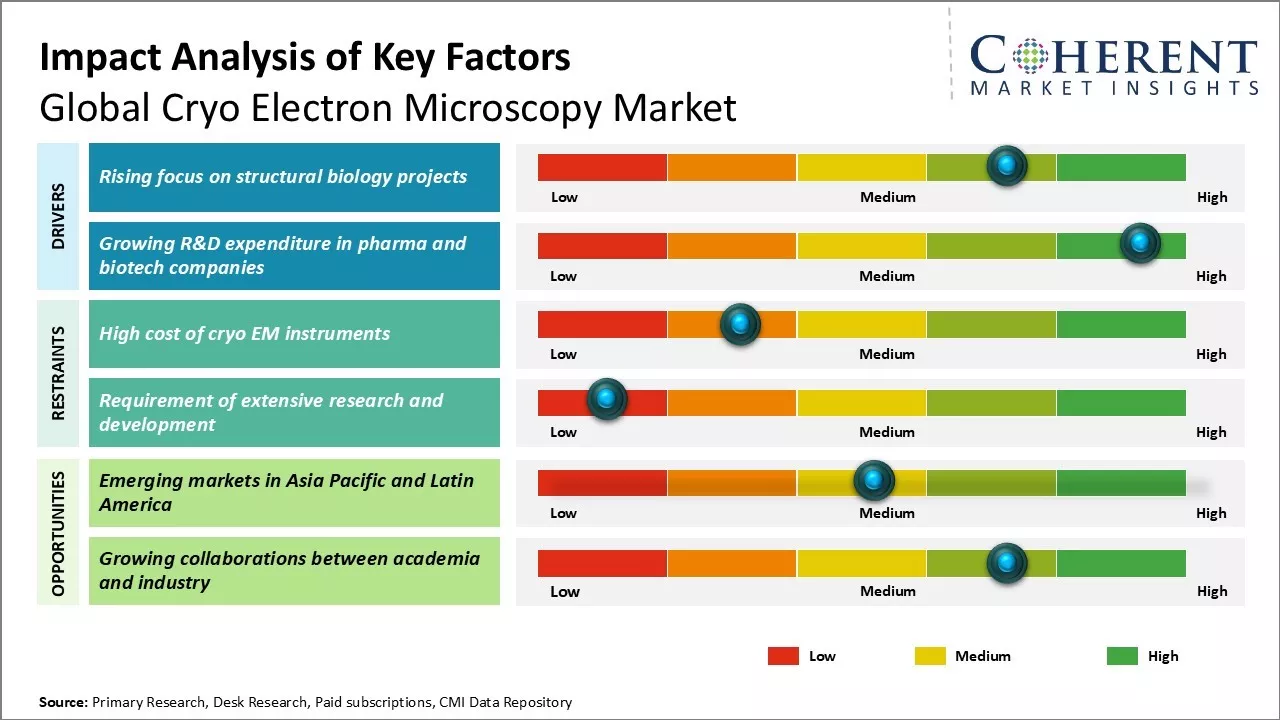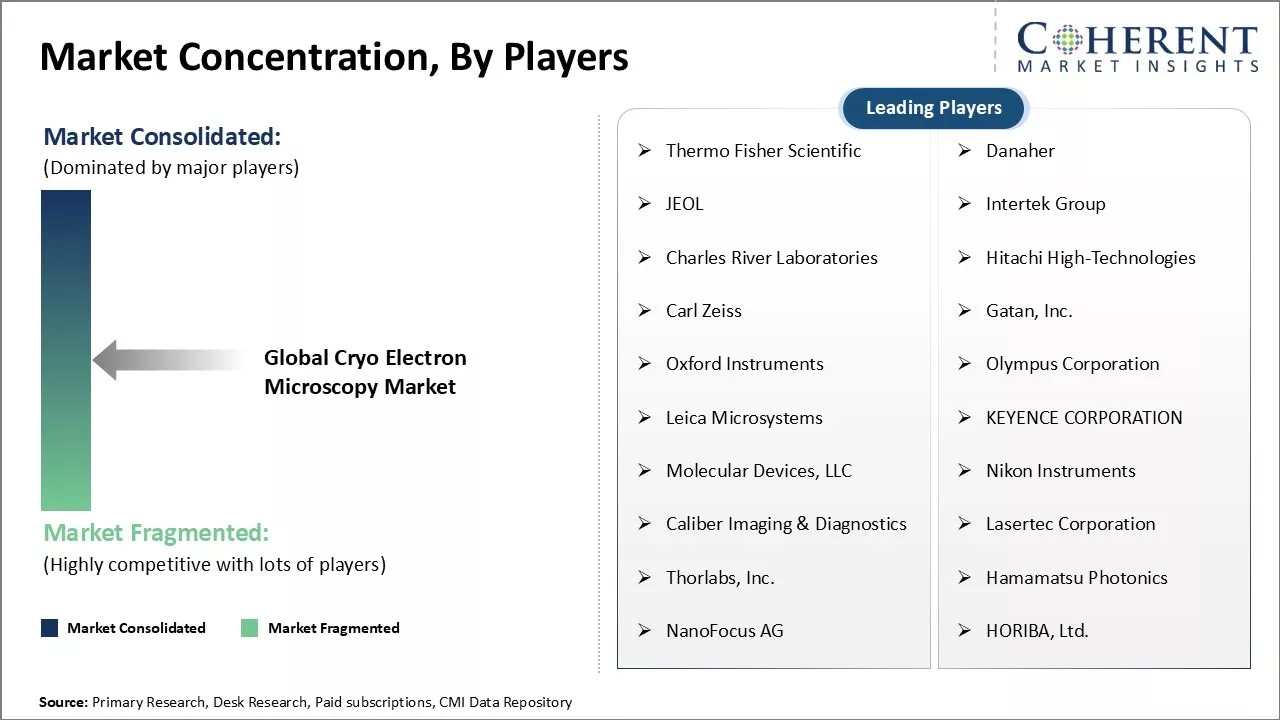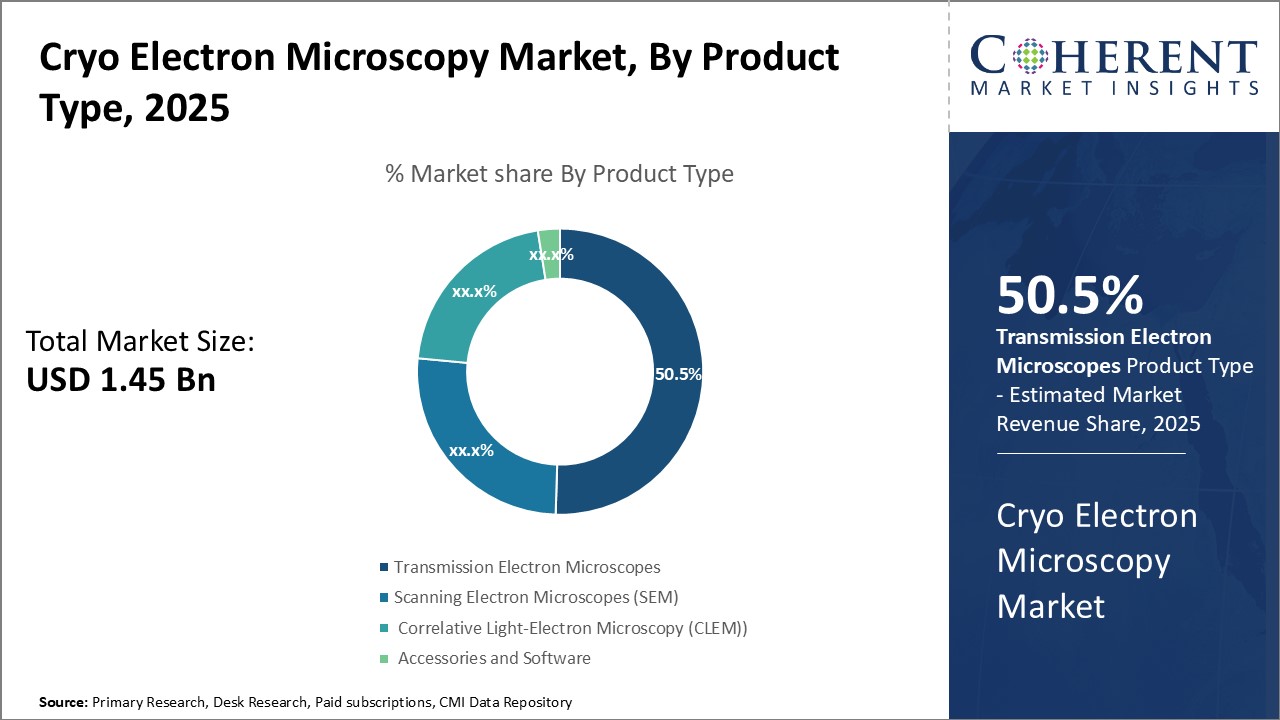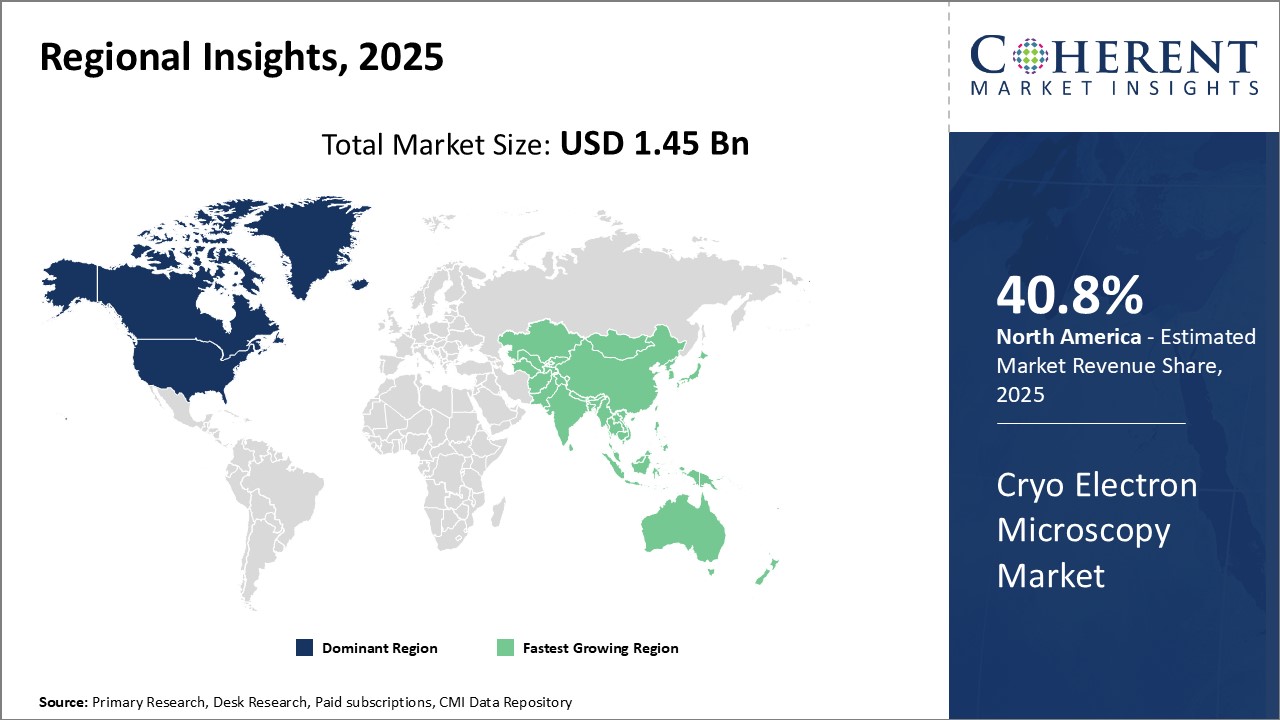Cryo Electron Microscopy Market Size and Trends
The Global Cryo Electron Microscopy Market is estimated to be valued at USD 1.45 Billion in 2025 and is expected to reach USD 3.18 Billion by 2032, exhibiting a compound annual growth rate (CAGR) of 11.9% from 2025 to 2032.

Discover market dynamics shaping the industry: Download Free Sample
The global cryo electron microscopy market is expected to witness significant growth over the forecast period. The market growth is driven by factors such as rising funding for cryo-EM from government and private organizations, technological innovations such as direct electron detectors and patterned beam technologies, and increasing applications of cryo-EM in drug discovery, material science, and healthcare industries. Furthermore, the high demand for cryo-EM over other microscopes owing to its ability to capture images at an atomic level with minimal sample preparation is also expected to support market growth during the projected period. However, the high cost of cryo-EM systems and technical challenges associated with sample preparation and imaging may hinder the market growth to some extent.
Rising focus on structural biology projects
The global cryo electron microscopy market has been growing significantly over the past few years. One of the key drivers for this growth has been the rising focus on structural biology projects around the world. Structural biology involves determining the three-dimensional structure of biological macromolecules like proteins and nucleic acids. This information provides crucial insights into their function and mechanisms. Over the past decade, there has been a dramatic rise in structural biology projects aimed at furthering our understanding of important biological processes and furthering drug discovery efforts.
Several disease specific structural biology initiatives and protein structure databases have been launched by funding agencies and academic institutions. For example, the Protein Data Bank which is one of the largest repositories of 3D structural data of biological molecules now contains over 150,000 structures including many determined using cryo electron microscopy techniques. Cryo EM has emerged as the method of choice for many such structural determination projects due to its ability to resolve large molecular complexes without the need for crystallization. The technique has helped successfully determine the structure of several challenging targets like membrane proteins and viruses which were previously difficult to study using other methods.
The rising popularity of structural biology and the applicability of cryo EM to wider range of targets have led to increasing number of cryo EM facilities being set up globally. National labs, academic institutions as well as private sector players have invested in high-end cryo electron microscopes to support in-house structural research. While traditional X-ray crystallography continues to be widely used, cryo EM is attracting a growing user base and number of projects due to its unique advantages. The structural insights gained through these efforts are helping advance research in diverse areas ranging from infectious diseases to neurodegenerative conditions. This expanding scope and applicability of cryo EM technique for structural determination augurs well for future growth of the global cryo electron microscopy market.
Market Concentration and Competitive Landscape

Get actionable strategies to beat competition: Download Free Sample
Growing R&D expenditure in pharma and biotech companies
Another key growth driver for cryo electron microscopy market has been rising R&D investments by pharmaceutical and biotechnology companies. Cryo electron microscopy is increasingly becoming a core technology for structural biology programs in the pharmaceutical industry. The technique helps in expediting projects involving structure determination of protein drug targets, lead candidate molecules as well as larger complexes involved in diseases. The three-dimensional structural data provided helps in computer aided drug design to optimize lead candidates at a much faster pace than was previously possible. Many leading pharmaceutical companies have made major investments to set up in-house cryo EM centers staffed with expert microscopists and supporting infrastructure.
Moreover, the improved resolution capabilities of the latest generation cryo electron microscopes coupled with innovations in cryo EM workflows have further increased their utility. For example, structural studies are now possible on smaller targets like drug fragments which were challenging earlier. This expands the scope of cryo EM applications considerably. With continued growth in biopharma R&D spending anticipated in the coming years on technological innovations, demand for cryo electron microscopes and associated services from this end-user segment is expected to rise substantially. This will remain a key growth driver for the global cryo electron microscopy market.
Key Takeaways from Analyst:
The cryo electron microscopy market is poised to grow steadily over the next decade driven by increasing research activities in structural biology and molecular biology. Factors such as technological advancements enabling higher resolution images, automation of microscope operations, and easy to use software solutions will further support market growth. The development of direct electron detectors and improved sample preparation techniques have made cryo-EM a powerful tool for exploring molecular structures at near-atomic resolutions. This is expected to significantly boost the demand for cryo electron microscopes.
North America is currently the largest market for cryo electron microscopy due to heavy investments in research and presence of key market players. However, the Asia Pacific region is emerging as a high potential market and is expected to witness the fastest gains. Rising research expenditure, growing initiatives to establish national cryo-EM facilities, and supportive government funding are some factors driving the APAC market growth. Europe is also expanding at a steady pace backed by strategic collaborations between academia and industry players.
Restraints impacting the market include high capital investment requirements for setting up cryo-EM centers and skilled workforce shortage. However, developing applications across diverse fields ranging from virus research to neuroscience offer significant opportunities for aftersales services and consumables businesses over the long term. With continued technology innovations and wider accessibility, the cryo EM market is well.
Market Challenges: High cost of cryo EM instruments
One of the major challenges faced by the global cryo electron microscopy market is the high cost associated with cryo EM instruments. Cryo EM instruments have significantly higher price tags compared to traditional electron microscopes and other imaging technologies. The high-end cryo transmission electron microscopes can cost upwards of $5 million. Such steep price points make cryo EM technology out of reach for many small research facilities, universities, and start-up companies. The maintenance and operational costs of these systems also remain high throughout the lifespan. The pricy nature of cryo EM instruments limits their widespread adoption across various end-use industries. Recovering the investment costs takes a substantial amount of time. The high barriers to entry prevent new players from entering the market. Overall, the exorbitant prices associated with cryo EM devices hamper the growth prospects of this market to a large extent.
Market Opportunities: Emerging markets in Asia Pacific and Latin America
One of the key opportunities for players in the global cryo electron microscopy market lies in the emerging economies of Asia Pacific and Latin America. These regions have witnessed significant economic development and rise of biomedical research activities in recent years. Countries like China, India, Brazil, and Mexico are steadily improving their research infrastructure and healthcare facilities. This offers an opportunity to raise awareness about cryo EM technology. With rising disposable incomes, governments in Asia Pacific and Latin America are expected to increase funding for advanced research tools. Market leaders should focus on customized pricing and financing strategies to penetrate these developing cryo EM markets. Local manufacturing partnerships can further aid in market penetration. If tapped properly, the developing markets of Asia Pacific and Latin America have strong potential to emerge as high growth regions for the cryo electron microscopy market in the coming years.

Discover high revenue pocket segments and roadmap to it: Download Free Sample
By Product Type - Transmission Electron Microscopes: Advancements in Technology Driving Significant Growth
In terms of Product Type, the Transmission Electron Microscopes (TEM) segment is estimated to hold the highest share of 50.5% in 2025 owing to continuous technological advancements which are enabling high resolution imaging at nano and atomic level. Constant innovation in transmissive electron optics and detector technology has immensely expanded application outlook of TEMs. Integration of aberration correctors has revolutionized high-resolution imaging while improving energy resolution. Adoption of direct electron detectors has enhanced detection limits allowing acquisition of low dose micrographs. Cameras based on complementary metal–oxide–semiconductor have enabled high-throughput workflows. Additionally, sophisticated electron optics coupled with elevated specimen chambers now facilitate in-situ TEM experiments under various stimuli like heat, strain, illumination etc. Automated workflows and deep learning enabled algorithms are augmenting productivity Multifoods. Open architecture platforms also support seamless customization and expansion of modular components as per evolving research needs. These developments have significantly boosted TEM adoption across diverse fields.
By Application: Biological Science: Expanding Application Range Fueling Growth
In terms of Application, the Biological Science segment is estimated to hold the highest share 42.5% in 2025 driven by expanding application horizon of cryo-EM techniques. Being a non-destructive technique, cryo-EM has emerged as a powerful tool for structure determination of macromolecules and molecular complexes. It allows visualization of cellular and sub-cellular structures at near-native state without labelling or crystallography. This has boosted its uptake for studying cellular organization, membrane proteins, protein-protein interactions and virus structures. Growing focus on personalized medicine has also propelled research involving disease structures, biomolecular assemblies and pathways. Multidisciplinary collaboration with fields like genetics, immunology and neuroscience is further widening investigative scope. Development of simplified workflows and user-friendly software are also augmenting biological uptake of cryo-EM.
By End User - Academic and Research Institutions: Focus on Cutting Edge Research Driving Adoption
In terms of End-User, the Academic and Research Institutions segment is estimated to hold the highest share of 43.5% in 2025 driven by increasing focus on fundamental and exploratory research. Cryo-EM capabilities allow organizations to investigate ambitious research questions involving complex molecular systems. Advanced cryo-EM facilities established by national level research programs are accelerating structural biology initiatives. Collaborative networks among top academic labs are also driving knowledge sharing and technology adoption. Focus on multi-disciplinary partnerships as well as industry-academia research is enhancing impact. Moreover, recruitment of skilled workforce and emphasis on training next generation cryo-EM users is helping establish academic excellence. Funding opportunities like specialized grants and projects are further encouraging structural biology leadership. Better access management and open access models are maximizing impact and return on infrastructure investments. Together, these factors are propelling cryo-EM adoption across advanced academic research.
Regional Insights

Need a Different Region or Segment? Download Free Sample
North America has established itself as the dominant region in the global cryo electron microscopy market with an estimated share of 40.8% share in 2025. With strong presence of key market players and research institutes, the U.S. alone accounts for over 50.5% market share. Major manufacturers like Thermo Fisher Scientific, JEOL, and Zeiss have their headquarters and largest R&D facilities based in the U.S., driving new product development. Academic research is largely funded through government grants by NIH and NSF, promoting widespread adoption of cryo-EM across universities and national laboratories. Cryo-EM usage is well-integrated into structural biology curriculum, resulting in highly skilled workforce. Regulatory framework also supports new product approval, ensuring steady equipment upgrades. With solid economic and infrastructure support extended to the life sciences industry, North America allows for effective commercialization of novel cryo-EM technologies.
The Asia Pacific region has emerged as the fastest growing market for cryo electron microscopy in recent years. Countries like China, Japan, South Korea, and India are witnessing exponential growth in structural biology research centered around human diseases and drug discovery. This has accelerated investments into advanced research instrumentation from both public and private sectors. Local manufacturing of components by Asian groups has made systems increasingly affordable. Growing expertise in cryo-EM sample preparation and data processing is further fueling regional expansion. National level initiatives promoting biotech and pharmaceutical sectors directly support this trend. For example, China's ‘Made in China 2025’ policy aims to enhance self-sufficiency in healthcare technologies. Overall improving economic conditions combined with strong government R&D funding and rising academic collaboration in Asia Pacific region has propelled it to the forefront of the global cryo-EM landscape.
Market Report Scope
Cryo Electron Microscopy Market Report Coverage
| Report Coverage | Details | ||
|---|---|---|---|
| Base Year: | 2024 | Market Size in 2025: | USD 1.45 Bn |
| Historical Data for: | 2020 To 2024 | Forecast Period: | 2025 To 2032 |
| Forecast Period 2025 to 2032 CAGR: | 11.9% | 2032 Value Projection: | USD 3.18 Bn |
| Geographies covered: |
|
||
| Segments covered: |
|
||
| Companies covered: |
Thermo Fisher Scientific, Danaher, JEOL, Intertek Group, Charles River Laboratories, Hitachi High-Technologies, Carl Zeiss, Gatan, Inc., Oxford Instruments, Olympus Corporation, Leica Microsystems, KEYENCE CORPORATION, Molecular Devices, LLC, Nikon Instruments, Caliber Imaging & Diagnostics, Lasertec Corporation, Thorlabs, Inc., Hamamatsu Photonics, NanoFocus AG, and HORIBA, Ltd. |
||
| Growth Drivers: |
|
||
| Restraints & Challenges: |
|
||
Uncover macros and micros vetted on 75+ parameters: Get instant access to report
Market Segmentation
- By Product Type Insights (Revenue, USD Bn, 2020 - 2032)
-
- Transmission Electron Microscopes (TEM)
- Single Particle Analysis
- Electron Tomography
- Scanning Electron Microscopes (SEM)
- Cryo-Scanning Electron Microscopy (Cryo-SEM)
- Correlative Light-Electron Microscopy (CLEM)
- Accessories and Software
- Specimen Preparation
- Image Processing and Analysis
- Transmission Electron Microscopes (TEM)
- By Application Insights (Revenue, USD Bn, 2020 - 2032)
- Biological Science
- Material Science
- Nanotechnology
- Lifesciences
- Medical
- Semiconductor
- Others
- By End-user Insights (Revenue, USD Bn, 2020 - 2032)
- Academic and Research Institutions
- Pharmaceutical and Biotechnology Companies
- Contract Research Organizations (CROs)
- Government and Research Laboratories
- Others
- By Regional Insights (Revenue, USD Bn, 2020 - 2032)
- North America
- U.S.
- Canada
- Latin America
- Brazil
- Argentina
- Mexico
- Rest of Latin America
- Europe
- Germany
- U.K.
- Spain
- France
- Italy
- Russia
- Rest of Europe
- Asia Pacific
- China
- India
- Japan
- Australia
- South Korea
- ASEAN
- Rest of Asia Pacific
- Middle East
- GCC Countries
- Israel
- Rest of Middle East
- Africa
- South Africa
- North Africa
- Central Africa
- North America
- Key Players Insights
- Thermo Fisher Scientific
- Danaher
- JEOL
- Intertek Group
- Charles River Laboratories
- Hitachi High-Technologies
- Carl Zeiss
- Gatan, Inc.
- Oxford Instruments
- Olympus Corporation
- Leica Microsystems
- KEYENCE CORPORATION
- Molecular Devices, LLC
- Nikon Instruments
- Caliber Imaging & Diagnostics
- Lasertec Corporation
- Thorlabs, Inc.
- Hamamatsu Photonics
- NanoFocus AG
- HORIBA, Ltd.
Share
Share
About Author
Komal Dighe is a Management Consultant with over 8 years of experience in market research and consulting. She excels in managing and delivering high-quality insights and solutions in Health-tech Consulting reports. Her expertise encompasses conducting both primary and secondary research, effectively addressing client requirements, and excelling in market estimation and forecast. Her comprehensive approach ensures that clients receive thorough and accurate analyses, enabling them to make informed decisions and capitalize on market opportunities.
Missing comfort of reading report in your local language? Find your preferred language :
Transform your Strategy with Exclusive Trending Reports :
Frequently Asked Questions
EXISTING CLIENTELE
Joining thousands of companies around the world committed to making the Excellent Business Solutions.
View All Our Clients
